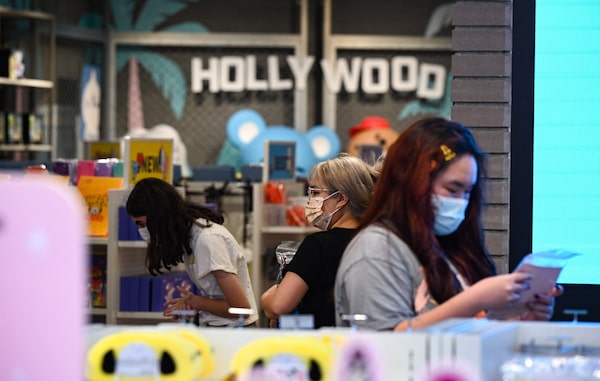
People shop at a store in Hollywood, Calif., on July 19.ROBYN BECK/AFP/Getty Images
U.S. retail sales unexpectedly increased in September, but there are fears that supply constraints could disrupt the holiday shopping season amid continued shortages of motor vehicles and other goods.
Retail sales rose 0.7 per cent last month, the Commerce Department said on Friday. Data for August were revised higher to show retail sales increasing 0.9 per cent instead of 0.7 per cent as previously reported. Sales last month were partly lifted by higher prices.
Economists polled by Reuters had forecast retail sales slipping 0.2 per cent.
A continuing global shortage of microchips is forcing automakers to cut production, leading to a scarcity of inventory at showrooms, which is boosting prices and limiting choice for buyers. Other goods are also in short supply amid congestion at ports because of a dearth of workers.
President Joe Biden on Wednesday announced that the Port of Los Angeles would join the Port of Long Beach, two of the country’s busiest, in expanding round-the-clock operations to unload an estimated 500,000 containers waiting on cargo ships offshore.
Spending shifted to goods from services over the course of the COVID-19 pandemic, straining supply chains. The rotation back to services such as travel and dining out has been slowed by a resurgence in coronavirus infections over summer, driven by the Delta variant.
Retail sales are mostly goods, with services, including health care, education, travel and hotel accommodation making up the remaining portion of consumer spending. Restaurants and bars are the only services category in the retail sales report.
“While visits to restaurants and retail locations have yet to break out of their late summer plateau, high-frequency card transaction data suggests spending remains solid,” said Sam Bullard, a senior economist at Wells Fargo in Charlotte, N.C.
Excluding automobiles, gasoline, building materials and food services, retail sales rose 0.8 per cent last month after an upwardly revised 2.6-per-cent increase in August. These so-called core retail sales correspond most closely with the consumer spending component of gross domestic product. They were previously estimated to have surged 2.5 per cent in August.
Economists believe consumer spending, which accounts for more than two-thirds of U.S. economic activity, almost stalled in the third quarter after a robust 12.0 per cent annualized growth pace in the April-June quarter. Consumer spending growth estimates for the third quarter are around a 2.0-per-cent rate.
Sluggish consumer spending also suggests that GDP growth braked sharply in the July-September quarter from the second-quarter’s 6.7-per-cent pace. The Atlanta Federal Reserve forecasts the economy grew at a 1.3-per-cent rate in the previous quarter.
The government will publish its snapshot of third-quarter GDP growth at the end of the month. Some of the anticipated slowdown in growth reflects the fading stimulus from trillions of dollars in pandemic relief from the government.
With hefty savings and a tightening labour market boosting wages, the foundation for the economy and consumer spending is solid. The saving rate increased at a 10.5-per-cent rate in the second quarter. There were 10.4 million job openings at the end of August.
“Of course, strong job gains and an elevated savings rate should provide consumers with an arsenal of available funds for spending after what appears to be a pause in the third quarter as the Delta variant spread and fiscal economic impact payments faded,” said Kevin Cummins, chief U.S. economist at Natwest Markets in Stamford, Conn.
Be smart with your money. Get the latest investing insights delivered right to your inbox three times a week, with the Globe Investor newsletter. Sign up today.